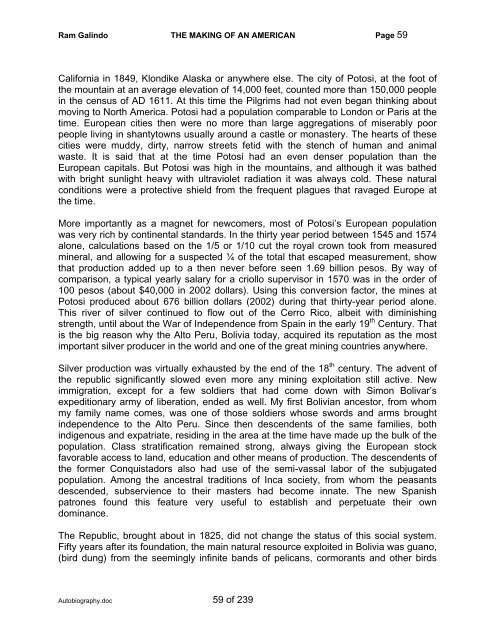Autobiography - The Galindo Group
Autobiography - The Galindo Group
Autobiography - The Galindo Group
You also want an ePaper? Increase the reach of your titles
YUMPU automatically turns print PDFs into web optimized ePapers that Google loves.
Ram <strong>Galindo</strong> THE MAKING OF AN AMERICAN Page 59<br />
California in 1849, Klondike Alaska or anywhere else. <strong>The</strong> city of Potosi, at the foot of<br />
the mountain at an average elevation of 14,000 feet, counted more than 150,000 people<br />
in the census of AD 1611. At this time the Pilgrims had not even began thinking about<br />
moving to North America. Potosi had a population comparable to London or Paris at the<br />
time. European cities then were no more than large aggregations of miserably poor<br />
people living in shantytowns usually around a castle or monastery. <strong>The</strong> hearts of these<br />
cities were muddy, dirty, narrow streets fetid with the stench of human and animal<br />
waste. It is said that at the time Potosi had an even denser population than the<br />
European capitals. But Potosi was high in the mountains, and although it was bathed<br />
with bright sunlight heavy with ultraviolet radiation it was always cold. <strong>The</strong>se natural<br />
conditions were a protective shield from the frequent plagues that ravaged Europe at<br />
the time.<br />
More importantly as a magnet for newcomers, most of Potosi’s European population<br />
was very rich by continental standards. In the thirty year period between 1545 and 1574<br />
alone, calculations based on the 1/5 or 1/10 cut the royal crown took from measured<br />
mineral, and allowing for a suspected ¼ of the total that escaped measurement, show<br />
that production added up to a then never before seen 1.69 billion pesos. By way of<br />
comparison, a typical yearly salary for a criollo supervisor in 1570 was in the order of<br />
100 pesos (about $40,000 in 2002 dollars). Using this conversion factor, the mines at<br />
Potosi produced about 676 billion dollars (2002) during that thirty-year period alone.<br />
This river of silver continued to flow out of the Cerro Rico, albeit with diminishing<br />
strength, until about the War of Independence from Spain in the early 19 th Century. That<br />
is the big reason why the Alto Peru, Bolivia today, acquired its reputation as the most<br />
important silver producer in the world and one of the great mining countries anywhere.<br />
Silver production was virtually exhausted by the end of the 18 th century. <strong>The</strong> advent of<br />
the republic significantly slowed even more any mining exploitation still active. New<br />
immigration, except for a few soldiers that had come down with Simon Bolivar’s<br />
expeditionary army of liberation, ended as well. My first Bolivian ancestor, from whom<br />
my family name comes, was one of those soldiers whose swords and arms brought<br />
independence to the Alto Peru. Since then descendents of the same families, both<br />
indigenous and expatriate, residing in the area at the time have made up the bulk of the<br />
population. Class stratification remained strong, always giving the European stock<br />
favorable access to land, education and other means of production. <strong>The</strong> descendents of<br />
the former Conquistadors also had use of the semi-vassal labor of the subjugated<br />
population. Among the ancestral traditions of Inca society, from whom the peasants<br />
descended, subservience to their masters had become innate. <strong>The</strong> new Spanish<br />
patrones found this feature very useful to establish and perpetuate their own<br />
dominance.<br />
<strong>The</strong> Republic, brought about in 1825, did not change the status of this social system.<br />
Fifty years after its foundation, the main natural resource exploited in Bolivia was guano,<br />
(bird dung) from the seemingly infinite bands of pelicans, cormorants and other birds<br />
<strong>Autobiography</strong>.doc 59 of 239


